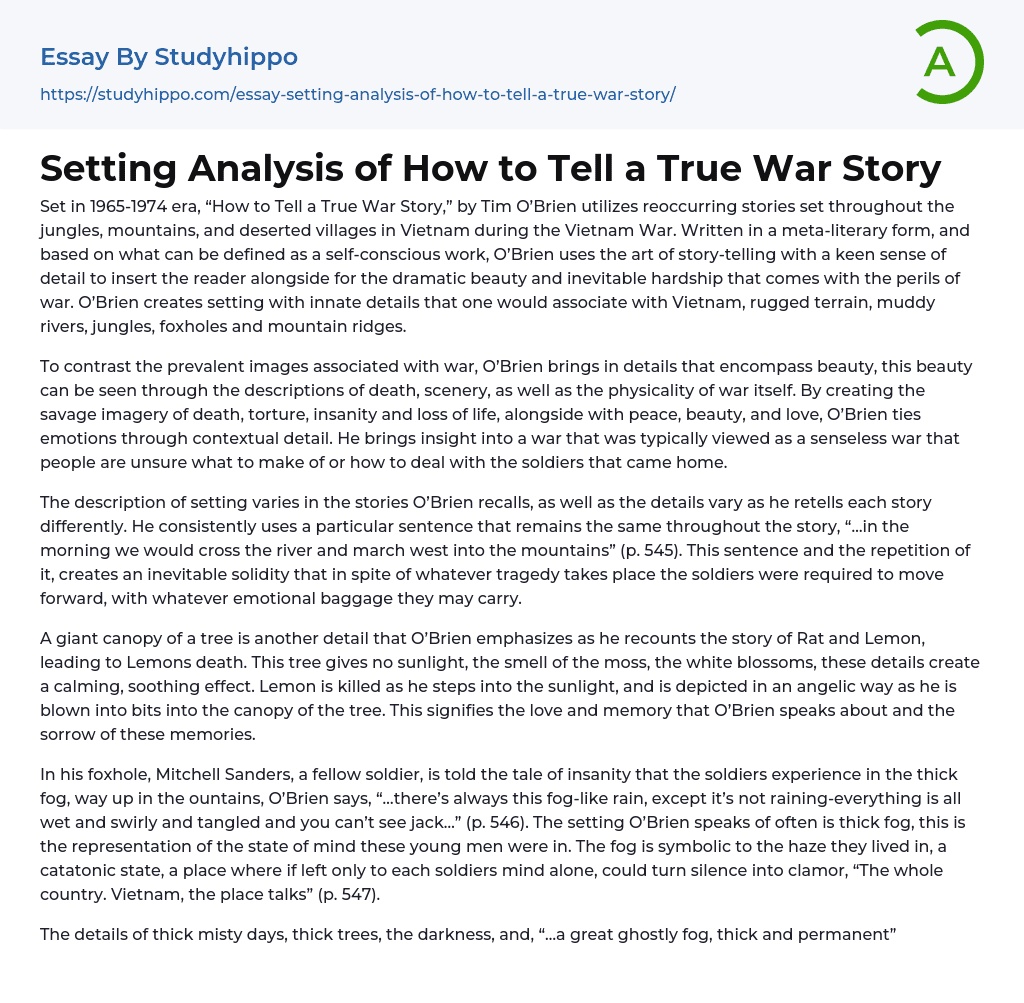

Setting Analysis of How to Tell a True War Story Essay Example
Set in 1965-1974 era, “How to Tell a True War Story,” by Tim O’Brien utilizes reoccurring stories set throughout the jungles, mountains, and deserted villages in Vietnam during the Vietnam War. Written in a meta-literary form, and based on what can be defined as a self-conscious work, O’Brien uses the art of story-telling with a keen sense of detail to insert the reader alongside for the dramatic beauty and inevitable hardship that comes with the perils of war. O’Brien creates setting with innate details that one would associate with Vietnam, rugged terrain, muddy rivers, jungles, foxholes and mountain ridges.
To contrast the prevalent images associated with war, O’Brien brings in details that encompass beauty, this beauty can be seen through the descriptions of death, scenery, as well as the physical
...ity of war itself. By creating the savage imagery of death, torture, insanity and loss of life, alongside with peace, beauty, and love, O’Brien ties emotions through contextual detail. He brings insight into a war that was typically viewed as a senseless war that people are unsure what to make of or how to deal with the soldiers that came home.
The description of setting varies in the stories O’Brien recalls, as well as the details vary as he retells each story differently. He consistently uses a particular sentence that remains the same throughout the story, “…in the morning we would cross the river and march west into the mountains” (p. 545). This sentence and the repetition of it, creates an inevitable solidity that in spite of whatever tragedy takes place the soldiers were required to move forward, with whatever emotional baggage
they may carry.
A giant canopy of a tree is another detail that O’Brien emphasizes as he recounts the story of Rat and Lemon, leading to Lemons death. This tree gives no sunlight, the smell of the moss, the white blossoms, these details create a calming, soothing effect. Lemon is killed as he steps into the sunlight, and is depicted in an angelic way as he is blown into bits into the canopy of the tree. This signifies the love and memory that O’Brien speaks about and the sorrow of these memories.
In his foxhole, Mitchell Sanders, a fellow soldier, is told the tale of insanity that the soldiers experience in the thick fog, way up in the ountains, O’Brien says, “…there’s always this fog-like rain, except it’s not raining-everything is all wet and swirly and tangled and you can’t see jack…” (p. 546). The setting O’Brien speaks of often is thick fog, this is the representation of the state of mind these young men were in. The fog is symbolic to the haze they lived in, a catatonic state, a place where if left only to each soldiers mind alone, could turn silence into clamor, “The whole country. Vietnam, the place talks” (p. 547).
The details of thick misty days, thick trees, the darkness, and, “…a great ghostly fog, thick and permanent” (p. 550), supplies the reader with an interpretation of heaviness and the weight on the soldiers morally. It provides a sense of cloudiness of that which was so unreal was truth and that which was so simplistic or morally correct was untrue. O’Brien’s use of vivid detail to recall
the story of the water buffalo displayed the moral anguish that these men faced when losing a comrade, and a loss of awareness though violence, anger, and sadness.
A construed way of grieving, as Rat acted savagely, he brought on relief to his inner pain. O’Brien brings a sense of beauty to his vision of this violent and unforgiving war. The setting sun, cool moon rising over the nighttime patties, white blossoms, and the smell of moss, are all terms that allows the reader to understand that these were still humans. These men still had hearts and in the midst of the blood and gore, they saw beauty, in their surroundings, in each other. They had a “…aching love for how the world could be and always should be…” (p. 550).
- World War I essays
- World War Ii essays
- Atomic Bomb essays
- American Civil War essays
- Attack essays
- Cold War essays
- Crimean War essays
- Emilio Aguinaldo essays
- Iraq War essays
- Korean War essays
- Nazism essays
- Nuclear Weapon essays
- Philippine Revolution essays
- Trench Warfare essays
- Vietnam War essays
- Western Front essays
- Diplomacy essays
- Emperor essays
- Rwanda essays
- Tribe essays
- Revolutionary War essays
- War of 1812 essays
- Mexican American War essays
- Hitler essays
- The Spanish American War essays
- League Of Nations essays
- Battle Of The Somme essays
- Treaty Of Versailles essays
- Fascism essays
- D-day essays
- Atomic Physics essays
- Atomic Bombings Of Hiroshima And Nagasaki essays
- Electron essays
- 1920S essays
- 1950S essays
- 1960S essays
- 19Th Century essays
- 20Th Century essays
- Ancient Greece essays
- Bravery essays
- British Empire essays
- Civilization essays
- Colonialism essays
- Declaration of Independence essays
- Evidence essays
- Genocide essays
- Gilded Age essays
- Historical Figures essays
- Historiography essays
- History of the United States essays



